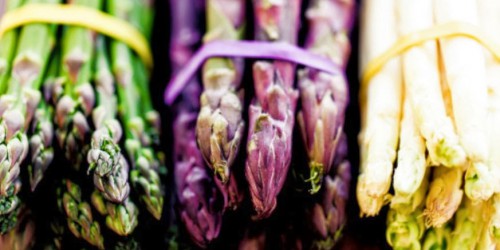Julius Caesar was a great asparagus eater. He ate it boiled and with butter spread on it. Even then it was a very popular vegetable and in the XIX century only a few could eat it due to its high cost: 40 francs for a bunch!
Asparagus is rich in fiber and water and that’s why it is recommended in case of suffering from constipation. Its sugar and fat content is very low. It contains folate (B9 vitamin – folic acid, recommended to pregnant women), A provitamin (beta-carotene) and C and E vitamin. These last three substances are antioxidant and they help reduce the risk of cardiovascular diseases, degenerative diseases and even cancer.
It’s important that the cooking time isn’t long as a high amount of folate and vitamins would be destroyed. For this reason I recommend to use a cooktop, steaming or blanching.
As for its bioavailable mineral content, we must highlight potassium and phosphor, as long as we are talking about fresh asparagus, as when canned these decrease while sodium amount increases because it is used to preserve the food.
This is the reason why only fresh asparagus has a diuretic action, which helps in the elimination of liquids from the body. It is beneficial in case of hypertension, fluid retention and kidney stones (unless the latter are salts of uric acid or if there is hyperuricemia or gout, as asparagus is a source of purines, which turn into uric acid in our body. Consumption should be moderated in these cases).
There are three kind of asparagus based on its colour:
- White: the most tender one, which grows underground, it hasn’t been exposed to sunlight which is the reason why it lacks green pigmentation (chlorophyll). It contains a lower amount of vitamin compared to the green asparagus, specially folate and C vitamin. It also contains a lower amount of asparagine, a non essential amino acid (we can synthesise it on our own) which is responsible for the characteristic smell in the urine of those who have been eating asparagus.
- Violet: it is gathered when the higher part of the sprout has come out to the surface and the coloration process has begun. It still has quite a delicate flavour although it is more tasty than the white one.
- Green: This one has completely come out of the ground and it grows in contact with sunlight, so chlorophyll develops and it shows a green colour. It’s still tender but it’s more tasty than the white and the violet asparagus.
Finally, as the article heading indicates, asparagus is a vegetable with low amount of histamine, therefore, people with DiAmino Oxidase (DAO) enzyme deficiency who are following a diet with low content of histamine, can enjoy its flavour without any worries.
Bibliography
– MURGADAS. F. Espàrrecs, Revista CUINA. p. 45 nº 157
– EROSKI CONSUMER. Espárragos: refrescantes y ricos en fibra. Mayo 2006






